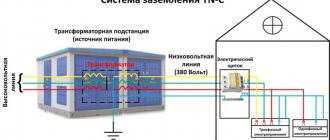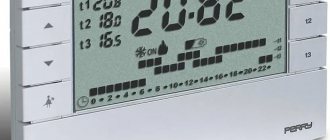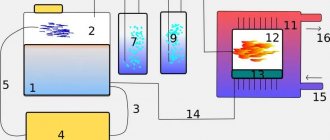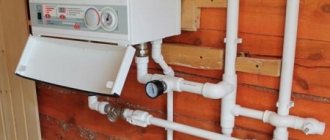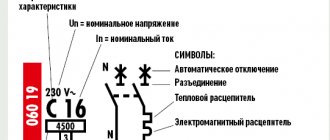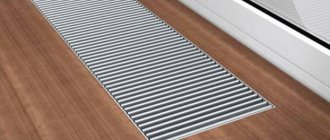Raising the set temperature to heat the room faster
If you've just walked into a cold house on a freezing winter day, it might seem smart to turn the thermostat up. But this will not help you feel warmth and comfort faster. The reason for this is simple: the thermostat doesn't control how quickly your home heats up, all it does is set the final temperature for your comfort level. It's best to think of a basic thermostat as a temperature limiter. This allows the heat to be turned on completely until the set temperature is reached, at which point the thermostat will turn the heat off until the temperature drops again. So, if you turn the thermostat above the comfort level, the system will overheat the space, making your home too warm and wasting significant energy.
How to adjust underfloor heating
If the house or apartment is not large, the region of residence is southern, heated floors can be left as the main source of heating. In other cases, it is made as a pleasant addition that will make life more comfortable. For example, in a children's room, in the bathroom or kitchen, in the work area. The thing is that you can’t make the floor very hot for obvious reasons. If it is minus 40 degrees outside, the heating system should be more powerful.
It is very convenient to have floors whose heating level is controlled. There are many devices for adjusting the temperature of a heated floor. Their work is based on a single principle.
Heating circuits are controlled individually through the installation of special manifolds that bring together the inputs and outputs of the heating system:
The temperature sensor for a water heated floor signals the thermostat that the temperature in the room (or on the floor surface) has increased. The chain includes a servo drive that controls the valves. Having received the appropriate signal from the thermostat, it admits a new batch of hot water into the system. Or, on the contrary, it will block its movement if the thermostat gives a signal that the room has become hot. The thermal valve for water heated floors helps regulate the flow of coolant. Such a thermostatic valve for underfloor heating allows you to effectively regulate the temperature of the coolant supply. A pump must be installed to pump water.
So, to control the temperature indicators of heated floors you need:
- a collector where all circuits are brought together;
- thermostat;
- temperature sensor;
- servo drive that controls the valves;
- pump for pumping water.
All this together makes it possible to make the heating system automated. This is not just convenience, but energy saving. Thermostats can be set so that in the absence of people the heating of the room will be reduced. Automatic machines allow you to save from 30 to 40 percent of energy resources. Moreover, this will not affect people’s living conditions; on the contrary, it will make staying in an apartment or house more comfortable.
In order to increase the safety of operation of devices, the installation of safety valves and protective fittings against voltage surges in the electrical network and overheating of electrical equipment is provided.
Shut-off and control valves
Varieties
- What shut-off and control valves can be used to regulate the temperature of a heating battery?
For this purpose, the following are routinely used:
- Chokes;
- Thermal heads.
The needle throttle is a screw valve with a conical metal valve. The adjustment is extremely simple: the stem with the valve is screwed in and out, while limiting the flow of coolant through the hole in the seat.
Needle throttle device.
The thermal head is an automatic regulator that allows you to focus not on the permeability of the line, but on the air temperature in the room.
The operating principle of inexpensive thermostatic heads uses the expansion of solids, gases and liquids when heated:
- When the target temperature is reached, the expanding working fluid of the thermal head pushes the valve towards the seat and blocks the coolant flow;
- When cooling, the valve is moved away from the seat by a return spring, and the heater begins to heat up.
Mechanical liquid thermal head.
In addition, on sale you can find electronic thermal heads with a temperature sensor and a servo drive powered by a galvanic element. They are easily recognized by the screen, which shows the set or current temperature in the room.
Electronic thermostat.
Prices
- How much do chokes and thermal heads cost?
Here are the approximate prices at the end of 2016 for Valtec products:
| Shut-off valve element (thread size 1/2 inch) | Price |
| Manual adjustment valve | 300 rubles |
| Thermostatic valve without thermal head | 600 rubles |
| Thermal head without valve, mechanical | 700 - 1200 rubles |
| Electronic thermal head without valve | 2000 - 5000 rubles |
| Set of thermostatic valve and mechanical thermal head | From 1200 rubles |
Polypropylene corner choke costs 284 rubles (1/2 inch size).
Liquid thermal head costing 900 rubles.
Alternatives
- How else can you regulate the permeability of the supply line to the heating device or heating circuit?
To adjust the permeability of individual sections of the circuit in the heating system, the following can be used abnormally:
- Screw valves;
- Ball and plug valves;
Brass plug taps.
Valves.
Let me emphasize once again: the use as chokes for all of the listed elements of shut-off valves is an abnormal mode.
What does it threaten?
With a screw valve, the half-open valve will continuously move in the turbulent coolant flow, since it is movably attached to the stem. As a rule, throttling with a screw valve ends with the valve breaking off, after which the valve stops closing or opening;
Disassembled screw valve. The valve is movably attached to the stem and, when beating in a turbulent flow, will sooner or later come off.
According to the manufacturers, the half-open position of the valve on a ball valve usually leads to wear of the fluoroplastic or Teflon rings that ensure tightness in the closed position - with quite predictable consequences. Less often, scale that gets between the valve and the body simply prevents the valve from closing;
Ball valve device. In the half-open position, the flow of water with abrasive particles wears out the O-rings.
The tap that limits the maximum water flow through the faucet has been in the half-closed position for the last four years and is still working.
Semi-closed valves are characterized by falling cheeks, completely blocking the coolant passage.
We have the best price for a room thermostat for a gas boiler!
Our established relationships with manufacturers allow us to offer our customers reasonable prices for products that are worthy in all respects. Prices for a room thermostat for a gas boiler start from 2000 rubles and can be supplemented with favorable discounts!
So I became the happy owner of a gas boiler, which I just had to connect to the thermostat. Of course, I could call a specialist and pay for his work, but this is not in my rules; I decided to connect the room thermostat to the gas boiler with my own hands. The article describes several ways to do this.
Installers advise installing thermostats in living rooms. Their installation in the kitchen, hallway or boiler room leads to system disorientation and false alarms. It is recommended to choose the coolest room or where there are the most people.
No heat sources such as radiators or heaters should be located near the thermostat. The device should not be exposed to direct sunlight. It is necessary to avoid placing the thermostat in a draft. It is also undesirable to be near electrical appliances that emit thermal noise.
The boiler is turned on and off by a special relay. The thermostat is connected using a terminal on the boiler at a specified location or via a thermostat cable. The programmer requires batteries to operate.
Before connecting the room thermostat, you need to read the instructions, which are located in the technical data sheet of the device. Usually the passport has a separate section dedicated to connecting the thermostat.
Room thermostat saves gas
To automatically control the temperature in the house, boiler manufacturers recommend using a room or weather-compensated controller with a continuous principle of controlling the boiler flow temperature.
You can also use a room thermostat of a two-position principle (ON/OFF), but with less efficiency.
Boilers of luxury categories, as a rule, are immediately equipped with a remote control unit. Installed on the wall of the room, such a unit allows you to remotely control and monitor the operation of the boiler, and also serves as a room thermostat.
A room regulator allows you to maintain a constant temperature in a heated room with high accuracy. With manual control, the range of temperature fluctuations is larger and deviations are more often towards higher temperatures. Every extra degree in the room leads to an increase in gas consumption for heating. In addition, using a thermostat, you can program an automatic decrease in the temperature in the house during certain periods (at night...). Refusal of manual control of heating temperature and installation of an automatic regulator to maintain the required temperature in the room can significantly reduce gas consumption for heating.
In addition, to change the boiler settings, the owner does not have to run to the boiler room. Custom boiler settings can be changed right in the house, on the thermostat.
A room thermostat or room temperature sensor is always installed in the largest room of a house or apartment.
Room thermostat saves energy
When the boiler operates without a room thermostat, the circulation pump runs constantly, consuming electricity. The room thermostat controls not only the gas burner, but also the circulation pump. The circulation pump, controlled by the room thermostat, operates intermittently, which saves energy and the life of the pump.
Setup and operation
You can set up the simplest mechanical and electromechanical TP yourself; to do this, you need to carefully study the manufacturer’s instructions.
Digital TRs are installed on expensive climate control equipment, which, as a rule, is supplied by the manufacturer. In this case, independent adjustment is not allowed. The first start-up of the regulator is carried out during the boiler setup, which is performed by certified organizations certified to carry out this work by the manufacturer. The maintenance of warranty obligations will depend on compliance with this rule.
During the first start-up of the equipment, the commissioning organization checks the functionality of the thermostat, sets it up for operation and explains to the maintenance personnel what a thermostat is, how it should be serviced and the procedure for setting the current settings for the operation of climate control equipment.
During operation, the TR must be in a clean condition, must not be exposed to water and other aggressive liquids, it must be protected from mechanical damage and not placed in direct sunlight. It is prohibited to disassemble the TR yourself and change its electronic circuits.
If these simple conditions are met, the thermostat will operate throughout its standard service life, efficiently performing its functions of controlling thermal processes.
Modern climate control equipment must be equipped with thermostats. This requirement is caused by the need to ensure energy efficiency of heating systems. Even the use of the simplest mechanical TP allows saving from 10 to 30% of fuel during the heating season.
The use of digital thermostats allows you to create comfort in your home, reduces monthly energy costs, increases the efficiency of climate control equipment and its efficiency, and simplifies control processes. All this leads to a reduction in overall harmful emissions into the environment.
How do servos change temperature?
Apply power to the room thermostat and turn on the heating. The servo drive is normally closed. Now you set the required temperature on the thermostat and if it is higher than the room temperature, the thermostat supplies power to the servo drive and it begins to open. The time for complete opening and closing of the servo drive is 3 minutes.
The coolant flows into the radiator and the temperature in the room begins to rise. When the room temperature rises to the one set on the thermostat, the thermostat cuts off power to the servo drive. The servomotor returns to the normally closed position using a spring built into it. And so on.
Adjusting room temperature with multiple radiators
According to its scenario, the principle of temperature regulation is the same with one radiator, but has some features.
In order to regulate the temperature of a group of radiators, it is necessary to rupture the radiator heating return line pipeline and insert a two-way valve under the servo drive into the line.
To do this, it is necessary to equip a niche on the floor in which a supply pipeline with shut-off valves and a return pipeline with valves for a servo drive will be mounted. All this is necessary for maintenance.
Since with a large number of such temperature control zones, you will not be able to embed valves into a pipeline that runs horizontally. Consequently, the pipelines must be mounted vertically, making for this purpose a kind of distribution manifold with a diameter larger than the main pipeline.
In this case, air will collect at the highest point, so to speak, of the distribution manifold. To remove air, you must use an automatic air vent.
In this case, the main connection system will be a two-pipe system with horizontal installation and forced circulation.
We determine the number of control zones. We install radiators and route the supply and return pipelines to the distributor.
We connect the supply pipelines through ball valves, and the return pipelines through two-way valves. Choosing a room thermostat. We determine its location. We install cables. We are finishing the premises.
After finishing, we install thermostats, servos and connect them. We supply power and enjoy the conditionally automatic regulation of room temperature with several radiators. In this case, I recommend mounting the air vent through a ball valve.
Regulator kit
Heating regulator (controller) – 1 pc.
Solenoid valve – 1 pc. (selected by the customer for the appropriate diameters of pipelines in buildings independently, not included in the delivery package)
Outside air temperature sensor – 1 pc. (not included in delivery)
Water temperature sensor in the pipeline – 1 pc. (not included in delivery)
(at the customer’s request, we can complete the Regulator with a valve and sensors)
For more details about installation, see the Regulator's passport.
The experience of using simple and reliable control schemes using existing equipment for heating subscriber connections and modern domestic controllers and solenoid valves has shown their high economic efficiency and reliability.
To order a regulator and for other questions, please contact tel. (495) 741-20-28
Ways to change temperature with radiators
The first way to regulate the temperature of radiators in a room is when you have one radiator installed in the room and it is covered with a screen. In this case, we will regulate the temperature in the room using a room thermostat and a servo drive.
First, select the location for installing the room thermostat. Usually it is located 1 meter from the door. At a height of 1 to 1.5 meters on the opposite wall from the door handle, so that when the door is opened, a flow of cold air hits the thermostat and it, in turn, immediately reacts to the temperature difference.
We mount a valve under the thermal head onto the radiator supply pipeline, onto which we screw a servo drive for heating systems.
The servo needs a 220 volt power supply. Its power is 2-3 watts. We lead the cable from it to the room thermostat.
Room thermostats are divided into two groups: electronic and mechanical. Mechanical thermostats have almost become obsolete these days, but they are the easiest to install. They work like a regular switch. Supply power to the thermostat. Through it you break the phase to the servo drive and that’s it. Whether or not the thermostat supplies power to the servomotor.
Electronic thermostats are simple, in terms of turning on and off, and there are programmable thermostats.
In turn, electronic thermostats come in two types based on their operating principle:
The first are thermostats that require mains power to operate. Usually 220 Volts. That is, they are supplied with power separately. And the cable to the servo drive is mounted separately from the thermostat.
The second type of thermostats does not require mains power, since such thermostats are equipped with a battery. In this case, as with mechanical thermostats, the phase is simply broken through it to the servo drive, and the zero goes to the servo drive without a break. In this case, all thermostats must be connected to your machine in the switchboard for its quick replacement or maintenance.
Types of thermostats with air temperature sensor
To maintain a given temperature, thermostats are used, which, based on their operating principle, are divided into electronic and mechanical. The former receive information through built-in thermometers, and the latter through the expansion of bimetallic plates. Depending on the material, the sensors are bimetallic, made of reinforced plastic. In addition, they are divided into remote and built-in. According to the method of controlling the temperature range, there are:
- with control by air sensor;
- with control by floor sensor;
- combined.
Thermal relay
Modern thermostats with temperature control can be designed for incubators, infrared heaters, underfloor heating systems, etc. Some modifications are equipped with a touch display with indication and bright backlight. Thermostats with a remote sensor, which are a type of room devices, have become quite widespread. They are used to control heating devices. A good purchase might be:
- model name: National Comfort TR 721;
- price: 4220 rub.;
- characteristics: type – electronic, power – 3500 W, for heated floors, range – +5..+35°C;
- pros: programmable, costs less than analogues;
- cons: relatively small temperature range.
When planning to buy a thermostat with a remote-type air temperature sensor, check out another electronic option. Programmable thermostat is designed for heated floors:
- model name: THERMO Thermoreg TI-950;
- price: 6259 rub.;
- characteristics: type – electronic, power – 3600 W, range – +5..+40°C;
- pros: programmable;
- cons: expensive.
Mechanical thermostats with a remote air temperature sensor are much cheaper than their electronic counterparts. At the same time, they are practically not inferior to them in terms of body design:
- model name: National comfort TR 111;
- price: 2318 RUR;
- characteristics: power – 3600 W, range – +5..+45°C, installation method – hidden;
- pros: cheap, good temperature range;
- cons: none.
With built-in sensor
A correctly selected thermostat will help regulate the optimal intensity and temperature conditions of heating elements, for example, heating radiators. A convenient option is an electronic programmable controller with a digital display and timer. To save on your purchase by taking advantage of a discount, look for stores that often hold sales and promotions. Electronic thermostat for electric heating field with built-in sensor:
- model name: Schneider Electric Unica MGU5.501.18ZD;
- price: 4140 rub.;
- characteristics: network parameters – 230V, 50Hz, load – 10A, temperature range – +5..+30°C, measurement accuracy – 0.5°C;
- pros: relatively easy installation, durable front panel;
- cons: small adjustment range.
Three-contact thermostat from Valtec - wall-mounted room version with built-in sensor. The value of the adjustable parameter is set using the adjustment wheel:
- Model name: Valtec VT.AC602.0;
- price: 1904 rub.;
- characteristics: adjustment range – +5…+40°C, housing protection degree – 20 IP, installation in a hidden wiring box;
- pros: low cost, good parameters;
- cons: none.
The next option is perfect for adjusting and maintaining a constant room temperature. The changeover contact will help prevent the heating and air conditioning systems from turning on at the same time:
- Model name: Schneider Electric Unica T MGU5.501.12ZD;
- price: 5170 rub.;
- characteristics: network parameters – 230 V, 50 Hz, load – 10A, adjustment range – +5…+30°C;
- pros: simplicity and ease of control;
- cons: small temperature range.
With socket
On sale in Moscow, St. Petersburg and other cities you can find dozens of modifications of temperature controllers equipped with an outlet. A good choice might be a device with a Novatek Electro TP-12 voltage relay and a sensor that plugs into an outlet:
- model name: Novatek Electro TR-12;
- price: 1720 rub.;
- characteristics: control range - -10...+90°C, measurement error - about 1°C, minimum and maximum voltage - 120 and 320 V, dimensions - 122x61x76 mm;
- pros: can be used in different places (incubators, greenhouses, residential premises, etc.), low cost;
- cons: none.
Do not forget that the installation of an external thermostat or other device of this type and further operation require following certain recommendations. Another good buy:
- Model name: Sardo ST-0618;
- price: 1995 RUR;
- characteristics: operating voltage – 220..230 V, 50 Hz, degree of protection – IP30, dimensions – 105x60x80 mm, weight – 134 g;
- pros: low cost, LCD display;
- cons: none.
The following design is a single-channel electronic thermostat with a socket. Suitable for controlling underfloor heating, convectors and IR heaters:
- Model name: Sardo ST-0618;
- price: 1970 rub.;
- characteristics: control limits – 0..30ºС (with an accuracy of ±1ºС), maximum load current – 16A, degree of protection – IP20, dimensions – 124x57x83 mm, weight – 190 g;
- pluses: presence of an LCD display, reasonable cost;
- cons: small adjustment range.
Room air temperature sensor
Temperature sensors in most cases are protected from external influences by a glass bulb, and the wire is covered with PVC insulation. A thermostat installed in the room will help regulate the temperature in the room according to the preferences of all family members. Alternatively, pay attention to a thermostat with an air and floor sensor:
- model name: Unica Basic 55 TH 0502RS;
- price: 3100 rub.;
- characteristics: color – white, material – plastic, degree of protection – IP20 (for dry rooms), installation – built-in;
- pros: there is a display;
- cons: low level of protection.
You can order a thermostat of Aura, Grand or another brand with delivery by mail in a specialized online store at any time. Indoor version from Siemens:
- model name: Unica, Basic 55 TH 0502RS;
- price: 1872 RUR;
- characteristics: measurement range – 0…50°C, accuracy – ±0.8 °C, protection class – IP30, dimensions – 90x100x32 cm;
- pros: low cost, good quality;
- cons: none.
RTF1 is an option designed for measuring indoor temperature indicators. Suitable for offices, apartments, warehouse complexes and more:
- model name: RTF1 S+S Regeltechnik;
- price: 1324 rub.;
- characteristics: measurement range – -30 .. +70°C, degree of dust and moisture protection – IP30, installation – on a flat surface;
- pros: cost, functionality;
- cons: none.
Wall
For wall mounting, thermostats with air sensors are used, which can be mortise or overhead. Pay attention to the electromechanical device used as an automatic air temperature controller in different rooms. Can be connected to electric heating systems:
- model name: Eberle RTR-E 6121;
- price: 950 rub.;
- characteristics: measurement range – +5..+30°C, connection – up to 3500 W, protection class – IP30, dimensions – 75x75x25.5 mm, weight – 0.1 kg;
- pros: good protection, low cost;
- cons: none.
The next option for wall mounting is no less suitable for installation in a dry and closed room. More details about the parameters of another Eberle thermostat:
- model name: Eberle RTR-E 6163;
- price: 1100 rub.;
- characteristics: measurement range – +5…+30°C, protection class – 30IP, dimensions – 75x75x25 mm, weight – 0.1 kg;
- pros: reasonable price, there is a network shutdown key;
- cons: none.
RTR-E 6202 – mechanical modification from Eberle with heating indication and the ability to connect an external timer. Conveniently located terminal row saves installation time:
- model name: Eberle RTR-E 6202;
- price: 1692 RUR;
- characteristics: measurement range – +5…+30°C, current – 10A, dimensions – 75x75x26 mm;
- pros: you can connect a timer;
- cons: costs more than analogues.
For sauna
When using electric sauna heating, you can connect another device - a thermostat equipped with air sensors. When specific temperature indicators are set, the device will turn off the heating elements, and when cooling they will turn on again. This approach will help you save on electricity bills:
- model name: Ratar-02K;
- price: 3926 rub.;
- characteristics: measurement range - -40...+125°C, rated load current - 10A, dimensions - 72x88x54 mm, weight - 0.4 kg;
- pros: suitable for a wide range of devices;
- cons: a little expensive.
The following device is also great for use in a sauna. It is designed for an active load of 20A when connecting a voltage of 220V:
- model name: T32M-02;
- price: 3000 rub.;
- characteristics: measurement range – +50..+150°C, load – 20A, there is a thermal cylinder 280 mm long;
- advantages: simplicity, reliability;
- Cons: somewhat expensive.
- How to cook funchose at home
- Inhalations for children: use and dosage
- What are the benefits of walnuts for men and women? Properties and composition, benefits and harms of walnuts
Pay attention to the device with analog control. It is suitable not only for saunas and baths, but also for controlling the operation of heating devices in greenhouses, rooms, tanks, etc.:
- model name: ART-18;
- price: 1980 rub.;
- characteristics: measurement range – -40..+140°C, load of executive relays (maximum) – 5, 10 or 16A (depending on version), dimensions – 90x50x70 mm;
- pros: reasonable cost, suitable for many devices;
- cons: none.
For heated floors
An air temperature relay with a sensor is widely used to regulate the temperature in a room with a heated floor system installed. Thanks to the right device, you can achieve truly comfortable conditions. Thermostat with remote air temperature sensor:
- Model name: Heat-Pro RTC-70;
- price: 2099 rub.;
- characteristics: measurement range – +5..+40°C, type – mechanical, degree of protection – IP20, power – up to 3600 W;
- pros: cost, good parameters;
- cons: relatively low protection from moisture and dust.
SE 200 is a device designed to control electrical heating systems, which include film heaters, heating mats, and cable sections. Control is provided by air and floor temperature sensors:
- model name: Teplolux SE 200;
- price: 5422 rub.;
- characteristics: measurement range – +5..+40°C, programmable, touch control, degree of protection – IP21, dimensions – 9x9x4.1 cm;
- pros: ease of control, LCD display;
- cons: relatively low protection, expensive.
Another electronic thermostat for heated floors. It is equipped with internal and external temperature sensors:
- Model name: Heat-Pro S-603;
- price: 2459 RUR;
- characteristics: measurement range – +5..+45°C, programmable, type – electronic, load current – 16A, dimensions – 8.6x8.6x0.9 cm;
- pluses: presence of an LCD display, reasonable cost;
- cons: none.
For heater
To control and maintain the temperature in a residential or industrial premises by turning equipment on and off, TR-1 is an excellent choice. This thermostat is suitable for convector, heat gun, fan and other heating and cooling devices:
- model name: DigiTOP TP-1;
- price: 1999 RUR;
- characteristics: measurement range – -55..+125°C, degree of protection – IP20, dimensions – 11x6x4 cm;
- pros: connection directly to sockets, digital control;
- cons: relatively low level of protection from moisture and dust.
Aura LTC 530 is a simple device suitable for adjusting and monitoring the operation of a warm floor or heater. The device is relatively inexpensive:
- Model name: Aura LTC 530;
- price: 2490 rub.;
- characteristics: control limits – -+5..+40°C, degree of protection – IP20, dimensions – 8x8x4 cm, weight – 150 g;
- pros: ease of operation, ultra-thin installation part;
- Cons: low protection from moisture and dust.
The advantages of the following electronic regulator are its ultra-flat design and original, sophisticated design. There is no switch on the front panel, but there is an ergonomic keyboard:
- Model name: Aura VTC 550;
- price: 2790 rub.;
- characteristics: control limits – +5..+35°C, installation type – built into the wall, dimensions – 8x8x.7 cm;
- pros: large LCD display with backlight;
- cons: none.
For heating boiler
The EVAN WiFi Climate ZONT-H2 device is an excellent solution for monitoring and adjusting an electric or gas heating boiler. The device is programmable and has remote control:
- model name: EVAN WiFi Climate ZONT-H2;
- price: 7480 rub.;
- characteristics: control limits – -30..+50°C, programmable, operating voltage – 10-28 V, dimensions – 7.7x8.6x3.3 cm;
- pros: ease of setup and management;
- cons: high cost.
Terneo RK – thermostat for electric boiler with temperature sensor D18-4. Has protection against internal overheating, can be used to protect water pipes from freezing and heating systems:
- Model name: Terneo RK;
- price: 2530 rub.;
- characteristics: control limits - -55..+125°C, load - up to 16 kW, 16A, dimensions - 7x8.5x5.3 cm;
- pros: ease of use, reasonable cost;
- cons: none.
The VT.AC614.0 thermostat has the ability to turn on or off any equipment that is responsible for maintaining the temperature regime and controlling boilers. More details about the device:
- Model name: VT.AC614.0;
- price: 1800 rub.;
- characteristics: control limits – +17..+90°C, supply voltage – 220 V, 50 Hz, switching current (maximum) – 3A;
- advantages: low cost, quick installation;
- cons: none.
Universal thermostat
There are many universal thermostats with sensors that detect air temperature. The device from Devi is suitable for controlling underfloor heating or full heating systems. Using a special smart timer, you can program modes for specific periods of time:
- model name: Devi Devireg 550 ELKO;
- price: 5313 rub.;
- characteristics: control limits – +5..+40°C, control – electronic, degree of dust and moisture protection – IP30, dimensions – 85x85x47 mm, weight – 110 g;
- pros: functionality, possibility of remote control;
- cons: high cost.
The universal thermostat Ratar-01 will cost less than the previous device. It is mounted on a DIN rail and is used as a built-in control unit for various heating systems and devices:
- model name: Ratar-01 Relsib;
- price: 2257 rub.;
- characteristics: control limits - -40..+120°C, dimensions - 72x88x54 mm, weight - about 400 g,
- advantages: simplicity and ease of use;
- cons: high cost.
A good universal option for heating and cooling systems is a thermostat from Spyheat. The device is mounted using an open installation method:
- Model name: Spyheat SDF-418H;
- price: 1890 rub.;
- characteristics: control limits – +5..+40°C, type – electronic, power – 3500 W, degree of protection – IP20;
- pros: simple operation, low cost;
- cons: low level of protection.
Adjusting heating appliances depending on the type of heating system
Before regulating the heating in an apartment, it is necessary to determine the type of heating system used.
Individual heating
In this case, adjusting the heating radiators is much simpler, since in most cases the systems are powered by a powerful heating boiler, in addition, a circulation pump is installed, and each heating device has a three-way valve.
The presence of valves on radiators allows rational use of heat by reducing the water supply to the radiator or completely disconnecting it from the system.
Central heating
In a central heating system, the question of how to adjust the heating battery in an apartment is decided depending on the pipe layout:
- With a two-pipe wiring diagram, two risers are installed, which ensure the supply of coolant to the heating devices and its return. The flow of hot water in the radiator is regulated by means of a separate valve and a manual or automatic thermostat, which is equipped with each heating device.
- The operating principle of a single-pipe system is to supply coolant to each radiator and return it to the main riser. Thanks to this scheme, the water temperature in heating devices on any floor is almost the same. Each heating device has a control valve on the supply side.
- Most multi-storey buildings have a heating system with vertical supply of coolant, which completely eliminates the possibility of adjusting the temperature in heating devices. With this scheme, the radiators on the lower floors heat up very poorly, so the apartments are always cold. The rooms on the upper floors, on the contrary, suffer from the heat.
Editor's Choice
"Teplolux" BiZone
Photo: Teplolux The most advantageous set of technical characteristics guaranteeing a high level of energy savings and operational safety for the BiZone thermostat from the Teplolux company.
The device controls any climate control equipment, relying on data from two remote temperature sensors in different zones and one air temperature sensor built into the gadget’s body. Standard sensors of type TST02-2.0 can also be connected to sensors from other companies with a resistance of 10, 12, 15, 33, 47 kOhm.
BiZone functions:
- Setting and maintaining a work schedule;
- Work according to smart home scenarios created in the Tuya Smart service;
- Changing the rotation speed of fans of thermal appliances;
- Displaying information about energy consumption in graphical form.
Connection to the smart home structure occurs after scanning a QR code with a smartphone either in the product passport or on the manufacturer’s website. The installed and current operating modes are displayed on the front side of the device with multi-colored LEDs.
Technical specifications
| Adjustable temperature range | from 5°С to 45°С |
| Mains voltage | 230 V |
| Highest power | up to 3.6 kW |
| Maximum control channel current with active load | 5 A |
| Maximum control channel current with inductive load | 2 A |
| Degree of protection | IP44 |
Advantages and disadvantages
Temperature control in two zones simultaneously
Not detected
Editor's Choice
Teplolux BiZone
Dual zone thermostat
Independent control of two zones remotely via WiFi via the TUYA application, integration into the smart home system and IP44 moisture protection class.
OrderDelivery terms
Types of devices
Devices intended for control differ in design, but the principle of operation of the temperature controller is the same. They may involve mechanical, electronic components, or combinations thereof. There are currently 4 types of compact indoor appliances on the market:
- mechanical;
- electronic;
- programmers;
- wireless, radio controlled.
Models are used for underfloor heating systems, radiators, electric heaters and boilers.
Mechanical regulators
These are the simplest, practically trouble-free models. All settings are made manually. Thermostats designed for heating systems differ in the sensitive medium that is located inside the bellows. Therefore, mechanical devices on sale can be found in two types - liquid and gas-filled. The first devices are distinguished by their low price, the second - by greater reliability.
Gas-filled models have better speed and smoother response to temperature changes. Another advantage is the minimal influence of the coolant parameters on the gas environment of the thermostat bellows. Liquid regulators are characterized by greater precision in transmitting pressure to the rod.
The disadvantages of mechanical thermostats include:
- the need for manual configuration, it often requires adjustment;
- some inaccuracy of temperature indicators; the difference from the actual air or water temperature may be 4-5°.
The main advantage of such regulators is their reasonable price. Durability is the second plus, since in the simplest design there are practically no elements that can unexpectedly fail. Other models have a similar principle of operation of the temperature controller, but their equipment is more complex.
Electronic thermostats
These devices are more expensive, but they provide owners with the opportunity not to worry about constant monitoring of their operation. Such regulators provide settings with smooth changes in parameters at certain times of the day. They do not need any adjustment if the temperature outside the window increases or decreases.
All necessary indicators can be seen on the informative display. It can be push-button or touch-sensitive. For the convenience of owners, the kit includes a remote control. The disadvantages of the models are higher cost, risk of electronic failure.
Regulators-programmers
Programmable thermostats are quite expensive devices that have several modes and programs. But with their help, it is possible to constantly monitor the heating system, create the most comfortable microclimate, and configure it to save energy resources.
Analog devices have a Wi-Fi system that allows you to monitor and control work via a smartphone or tablet. However, for maximum convenience you will have to pay a large amount. Programmers have no other disadvantages, besides the possible failure of rather complex equipment.
Wireless models
A radio-controlled device (programmable thermostat) is perfection, because of which you will have to put up with the highest price of the device. But their big advantage is the absence of an electrical cable. Such equipment is intended for those owners who do not want to “spoil” the interior with either wires or additional sockets.
More often, a temperature controller is needed for a heating system, especially if it is the only or main source of heat. In this case, it is recommended to equip it with an electronic or programmable thermostat. Any device that has a heating sensor is suitable for auxiliary heating equipment.
Thermostat functionality
A room thermostat is a small unit with controls that is mounted at one point or another in an apartment or house. By connecting to a heating boiler, it allows you to control its operation, control the temperature in the room, and set certain operating modes. A room thermostat is convenient when the boiler is located in a technical room or in the basement. It will also be useful in large houses - for example, we can set the desired temperature from a thermostat located on the second floor, while the boiler is on the first floor or in the basement of the building.
There is no need to install the thermostat in close proximity to the heating equipment.
A room thermostat cannot be called a vital device. On the contrary, we can do without it, saving money in the budget. The thermostat only provides ease of control of heating equipment. It will also be able to save money in your wallet, being equipped with a built-in temperature sensor. Let's see what functions a room thermostat has:
- Controlling the temperature in the heating circuit - just turn the knob or set the required value using the buttons;
- Setting the temperature during the day and at night - we create a comfortable environment at any time of the day;
- Programming operating modes - for example, during the daytime the temperature can be reduced, since all household members are at work. Towards evening, the room thermostat will command the temperature to increase to make the rooms warmer;
- Temperature control using a built-in sensor – ensures gas savings;
- Control of additional equipment - for example, weather-compensating automation or a solar collector.
The simplest room thermostats have minimal functionality. The basic function is temperature control, and we can call all the others service functions.
What is the optimal temperature in the refrigerator?
The latest models have a fairly large refrigerator compartment, through which the heat is not distributed in even layers.
Heat distribution depends on the location of the compressor and the design of the refrigerator itself.
So, for some manufacturers the biggest minus is at the top, while for others it is in the middle. The closer to this place, the colder it gets.
How to set up the refrigerator and where to put what food is influenced by:
- +1-3 is needed for meat, fish, eggs, hard cheeses, open sauce.
- +2-4 suitable for sausages, soft cheeses, cooking.
- +3-5 ideal for soup, boiled vegetables, milk, bakery products.
Seafood is best kept at +4-6. Place the fruit where it is warmer, unless it is a banana or other exotics that do not need cold.
Understanding now more, it will be easy for you to distribute the package from the store to the right shelves.
Everything “lives” equally well in the freezer, so you should not set the chamber to maximum according to the instructions for the refrigerator.
Malfunctions
In some cases, the operation of the device is disrupted by air pockets. They can be eliminated by bleeding the air using a Mayevsky valve. A decrease in heat transfer results from blockage of the pipe passage with sediment or rust. To get rid of dirt, it is recommended to rinse the radiator with special products.
In centralized systems, the temperature of the coolant may decrease as a result of an emergency on the main pipeline or unauthorized actions of neighbors that caused a change in the flow parameters in the common riser. Circulation is worsened by a broken valve at the radiator inlet or an incorrectly installed plug.
Most likely it will be enough:
- release air;
- wash the battery from the inside;
- change the valve.
As a rule, after performing one or several actions, the previous heat transfer is restored.
Is it possible to save on central heating fees?
Theoretically, the answer is yes, but in practice everything is not so simple. Let's assume that you decide to install a smart thermostat with programmable thermostats in your apartment. As a result of equipment operation, resource consumption will be reduced by about a third. This will also depend on the amount of heat loss from the home and other factors. But this fact will not affect the amount in the payment in any way.
The fact is that residents in apartment buildings pay for heating according to so-called standards or according to meter readings. The latter can be individual or communal. In our case, in order to register the fact of reduced resource consumption and, accordingly, reduce heating fees, you will need to install a heat meter in the apartment. This is not always possible.
Building heating regulator to eliminate overheating
| Heading: | Saving thermal energy When consumed. |
| Technology classification: | Technological. |
| Status of consideration of the project by the Coordination Council: | Not considered. |
| Implementation objects: | General house systems, incl. apartment buildings, social institutions (schools, hospitals, kindergartens, etc.), administrative and public buildings and structures. |
| Effect of implementation: | Saving thermal energy 25-40% Easy installation and operation Reduced operating costs |
How to adjust (reconfigure)
All thermostats are factory adjusted. But their settings are standard and may not match your desired parameters. If you are not satisfied with something in the work - you want it to be warmer/colder, you can reconfigure the thermostat for the heating radiator. This must be done with the heating running. You will need a thermometer. You hang it at the point where you will control the state of the atmosphere.
- Close the doors, put the thermostat head in the extreme left position - completely open. The room temperature will begin to rise. When it becomes 5-6 degrees higher than what you want, turn the regulator all the way to the right.
- The radiator begins to cool down. When the temperature drops to a value that you consider comfortable, begin to slowly turn the knob to the right and listen. When you hear the coolant making noise and the radiator starting to warm up, stop. Remember what number is on the handle. It will need to be set to achieve the required temperature.
Adjusting the thermostat for a radiator is not difficult at all. And you can repeat this action several times, changing the settings.
How to properly regulate the temperature
To create a comfortable temperature in the room, you need to understand how to regulate the radiators in the apartment. Therefore do the following:
- The heating device is vented until a thin stream of water appears.
- The pressure in heating devices is adjusted.
- In systems with forced circulation of coolant, the amount of heat is regulated by special valves.
- In flow-through systems, temperature control is carried out by a thermostat built into the heating device.
- In two-pipe systems, the amount of coolant in the radiators is controlled in parallel with the temperature.
To ensure that your living space is always warm and cozy, you need to know how to use a heating radiator and install an adjustment system on each device. With the help of modern devices, conditions for a comfortable stay are created in the room and energy costs for heating the coolant are saved.
What does the term “thermostat” mean?
A thermostat is a device that is used in heating or air conditioning systems to ensure the set temperature of the heated medium: water or air.
As a rule, a thermostat (TR) is made in the form of a hardware module that measures the temperature of the medium and transmits a signal to the control module to activate or stop the heating process.
Thus, there are two executive modifications of the thermostat:
- It acts as an independent device that has functions to monitor and manage the process, for example, temperature control and its regulation based on the percentage of humidity in the room;
- as a hardware module as part of general security automation.
Types of control valves
There are several taps that can be used to regulate the temperature of the batteries:
Conventional ball valve. It is not recommended for them to regulate the temperature, since it is designed exclusively for two positions: opening and closing. At intermediate values, the ball inside the tap will wear out quickly
- Radiator shut-off valve (straight or angled). Suitable for rough temperature adjustment. But since the radiator does not react to changes immediately, the function of the valve is reduced only to opening and closing the radiator.
- Faucet with thermostatic head. A convenient autonomous solution for adjusting the temperature of radiators. It has a temperature scale and, depending on the temperature in the room, either opens the supply or closes it
- Two-way valve with servo drive. The most advanced and expensive solution. Used extremely rarely. Used in conjunction with a thermostat. The temperature is set on the thermostat and when it is reached, the servo drive opens or closes the supply.
Why is it important to set the refrigerator temperature correctly?
Many products that spoil quickly should “live” at +2-5 degrees. If the temperature is higher, they freeze and lose their quality. And after defrosting it spoils almost immediately.
If, on the contrary, the chamber is very warm, then bacteria multiply with pleasure. This can be understood by “dead” greens, mold on sausage or cheese, or fermented soup.
The big plus affects freezing even worse. Meat will remind you of itself with a bad smell in just a couple of hours.
In addition, if you set the temperature in the No Frost refrigerator incorrectly, you will constantly complain about high energy consumption. And in some models, remove melted ice.
Signs by which you can understand that the temperature in the refrigerator is set incorrectly:
- Ice forms inside.
- High energy consumption.
- Food spoils very quickly.
- Some products dry out in a couple of days.
- There is a foul smell.
Complete heating shutdown
Many people turn off the heating completely when leaving the house. However, this can put your home at risk of damp, mold and, in extreme conditions, burst pipes. To prevent adverse complications in very cold weather, it is recommended to use a lower temperature. A lower temperature does not mean the heating is turned off when you are outside the home. If the set temperature is suitable for your home, the heating will be switched off while you're out for a normal period of time, but protected from dropping too much if you're out longer than expected.
What temperature should the main heating thermostats be set to?
Getting to the target temperature for your home can take some time and may require some experimentation, but a good starting point is 16 degrees. The average home takes approximately 1 hour to warm up from 16 to 21 degrees, so you should adjust your program accordingly. Smart thermostats can save you the hassle of experimentation by automatically calculating the optimal temperature for your home when you're away and turning on the heating to warm your rooms just in time for your arrival.

